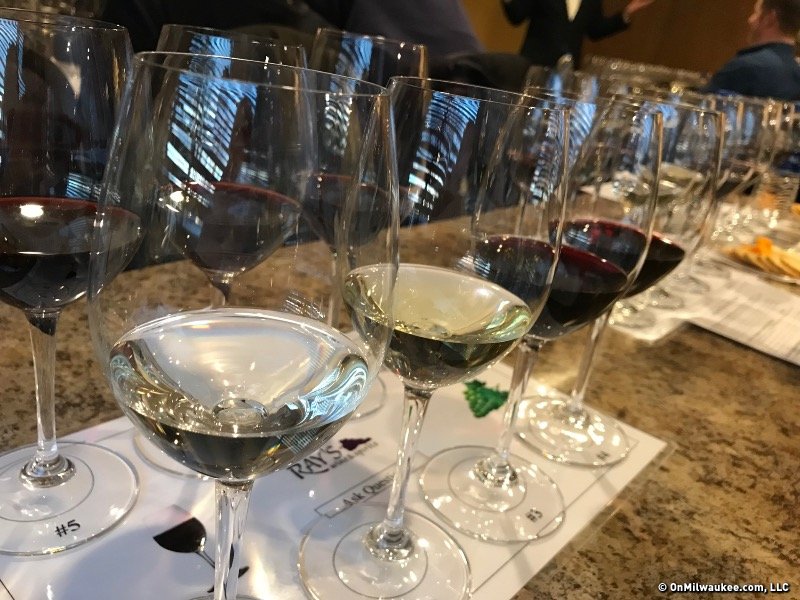Rosé has traditionally met with disdain by wine snobs for not having an impressive pedigree. It’s been dissed for being too sweet, too pink and just plain "too girly."
But, there’s something to be said for not judging a drink by its color.
"We all have an appreciation for summer here in Wisconsin. After all, it’s short," says Joshua Wolter, general manager at c.1880. "And it’s the same with rosé. Men in France have been enjoying a bottle of rosé over their lunch break forever, so why not Wisconsinites?"
Wolter points out that all-too-often pink is associated with the sugar-laden sips of White Zinfandel, but the world of pink wine, rosé to be specific, is full of pretty pink pours that are anything but girly.
Rosés are made from a number of red wine varietal grapes, including Pinot Noir, Cab Franc and even Sangiovese. In creating rosé, the grapes are allowed to soak with the skins for one to two days. Then they are crushed and the juice drawn off or pressed, then fermented without the skins. This allows the winemaker to give his wine more complexity by bringing out the very best aspects of the grape variety chosen for his rosé.
The pink color of a rosé can range from a pale "onion"-skin orange to near-purple, depending on the grape varieties used and winemaking techniques. And, what the average person may not know is that most of the best ones are not sweet. In fact, the vast majority are dry to bone dry.
"If you’re a fan of red wines," Wolter notes, "There’s still the same amount of complexity in a rosé; but it’s a bit lighter in both color and flavor."
Wolter credits his grandmother with sparking his interest in wine, early on.
"So, growing up, rosé to me was … wine. It was something my grandmother drank. And it came in a jug that she kept it under the counter, in the same spot we hid the Fig Newtons and the dish towels," he says. "It was my first taste of wine. It was sugary, boozy, flavorless. And it was cheap."
Wolter’s grandmother passed away just under a month ago, and he says one of the legacies she left behind was her love of wine.
"She was my life. She influenced me; I cooked with her, I drank wine with her, and we had fun with it," he recalls. "As I grew older, I began to take my own route away from the family. I was 18 or 19 and I brought wine to Thanksgiving. And it wasn’t good wine. But, it was different from what they were drinking. And Grandma loved it. She was just proud of me for doing something different. For me now to understand the definition of what rosé really is – it’s pretty cool."
Wolter says it’s been a personal mission to get people to realize that rosé isn’t a "jug wine" or something that comes out of box.
So, when Wolter invited me to sit in on a late night planning session for c.1880’s upcoming rosé dinner, I nearly leaped at the chance. But, my first question was – why rosé?
"Summer is here, and rosé is the perfect warm weather drink," he says. "It’s delicious. There are so many different types of rosés, so much difference between flavor profiles. And it’s so food friendly. The fact is, you can’t have a Bordeaux dinner in the middle of June. But, rosé screams summer. It screams: ‘Welcome to the next three months. Enjoy it while it lasts. Winter is coming.’"
We met in the newly renovated event space at c.1880 around 9:30 p.m. The last of the diners were bidding their goodbyes, and Chef Hauck had just finished up his service in the kitchen. And there were eight bottles of rosé to be tasted and paired.
"This won’t be the stuffy uptight wine dinner you’re picturing," remarks Wolter. "It’s good food, good wine. But, you should have fun and laugh a little. It’s like going to a concert."
We started by tasting Fentinel Brut Rosé, a sparkling rosé with just a bit of sweetness. And, as we tasted, Chef Thomas Hauck and Sous Chef Matt Miller discussed options for pairings.
Miler: "Could be the amuse. It’s fairly simple, straightforward brut. Nice for a reception in the beginning."
Hauck: "By then, we should have a lot of fruit. Could do oysters, or something with foie gras.
Wolter: "Rhubarb?"
Hauck: "The window might be closed, but maybe if we preserved something. Maybe with the foie gras."
Next up, the Valdomere, a 100% Pinot Noir, was yeasty on the nose.
Hauck: "It’s really dry. Super crisp."
Miller: "What’s it called again?"
Hauck: "Voldemere… Voldemort, the one who should not be named?"
Wolter: "Can we serve horcrux with that? What do horcruxes even taste like?"
Hauck: "Bitter. And very small," Hauck responded, grinning. "Metallic, I think."
Once the laughter dissipated, the chefs got back to serious talk.
Hauck: "Maybe radishes. Or watermelon. Maybe wrapped in prosciutto like a little bite. Maybe with chevre?"
The Fentinel, our next tasting, seemed to be a win for raw seafood, and Comanderie evoked thoughts of grapefruit and Marlborough Savignon Blanc.
Despite its somewhat "cheesy" name, Pink Fiddle, a rosé made from 100% Pinot Noir, met with a remarkably open minded reception.
Miller: "Well, this one’s not a dude rosé. But, it’s got good red berry flavor. It could go with olives or dates. There’s a little heat behind this. So, maybe Mediterranean."
Hauck: "Could be good with a bird,"
Miller: "Sweetbreads?"
Hauck: "Sure, we’ve never done those. Let’s put that down."
The Rhino, a unique blend using 50% Sangiovese grapes, met with quite a bit of interest for its unique flavor profile.
Hauck: "Huh. I like the idea of having a wine like this that doesn’t really look like a rosé. It’s groovy, earthy."
Miller: "Something anchovy for sure. Maybe olives."
Hauck: "Squab and olives, or pigeon and olives?"
Wolter: "The idea is that this is a dinner for men too. So, let’s not let this get too light."
And then Wolter rolled out a bottle of Ehlers Rosé, made from 100 percent Cabernet Franc.
Hauck: "Now this is a rosé. This should be with the final, savory course. Maybe veal? Duck?"
Following the tasting, Chefs Hauck and Miller further contemplated their choices and solidified a six course menu with pairings and an amuse bouche.
Ultimately, the final menu showcases both the versatility and appeal of summer rosés:
- Val de Mer sparkling Pinot Noir Rosé
- Hamachi with peaches, watercress and pistachio paired with 2013 Domaine Le Pive Rosé
- Crab, grapefruit, avocado and tarragon with 2013 Commanderie de la Bargemone Grenache Rosé
- Cochon de Lait (milk fed pork) with red currant, mustard and Peewee potatoes with 2013 Pink Fiddle Pinot Noir Rosé
- Sweetbreads with olive, fennel and anchovy paired with 2013 La Spinetta Sangiovese/Prugnolo Rosé
- Duck with apricot, almond and cherry alongside 2013 Ehlers Estate Sylviane Cabernet Franc Rosé
- Raspberry dessert featuring pate sable, white chocolate and lemon verbena paired with Fantinel Brut sparkling Pinot Noir/Chardonnay Rosé
Wolters says his hope for the dinner is that it evokes a new appreciation for the wine – and an opportunity to introduce people to a wine that’s perfect for popping open on a warm summer evening.
"I have so many good memories drinking rosé in the summer… watching the tomatoes blooming, the nasturtiums bursting with color In fact, I always say ‘Open a bottle of rosé now, you’ll have a memory five years from now.’"
Ultimately, he says, he hopes the dinner will help to dissipate the stigma of enjoying one of the wine world’s best kept secrets.
"There’s been a huge influx of great rosés coming to market," Wolter says. "And its popularity is growing. I mean, Brad Pitt and Angelina Jolie just bought a rosé vineyard. There’s nothing to be ashamed about. If you can wear a polo that’s pink, you can drink a wine that’s pink."
Get your pink drink on at the Rosé Wine dinner at c.1880 on Thursday, June 26. Cost is $90 per person, including rosé pairings. Reservations are required and can be made by contacting the restaurant directly either by phone at (414) 431-9271 or email reservations@c1880.com.
As a passionate champion of the local dining scene, Lori has reimagined the restaurant critic's role into that of a trusted dining concierge, guiding food lovers to delightful culinary discoveries and memorable experiences.
Lori is an avid cook whose accrual of condiments and spices is rivaled only by her cookbook collection. Her passion for the culinary industry was birthed while balancing A&W root beer mugs as a teenage carhop, fed by insatiable curiosity and fueled by the people whose stories entwine with every dish. Lori is the author of two books: the "Wisconsin Field to Fork" cookbook and "Milwaukee Food". Her work has garnered journalism awards from entities including the Milwaukee Press Club. In 2024, Lori was honored with a "Top 20 Women in Hospitality to Watch" award by the Wisconsin Restaurant Association.
When she’s not eating, photographing food, writing or planning for TV and radio spots, you’ll find Lori seeking out adventures with her husband Paul, traveling, cooking, reading, learning, snuggling with her cats and looking for ways to make a difference.



.jpeg)



